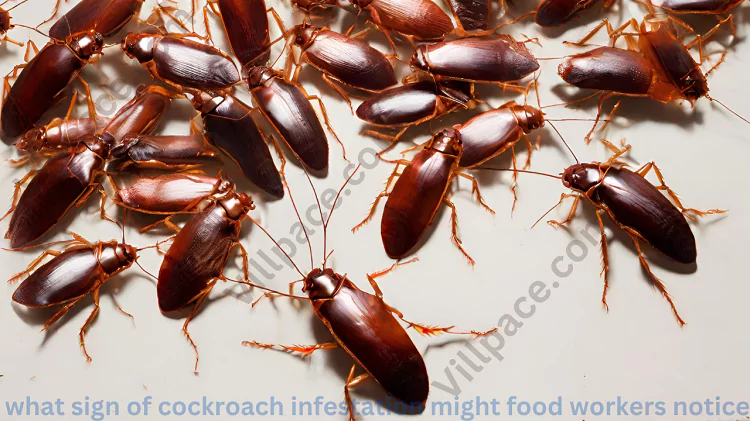Cockroaches pose serious health hazards, especially in food handling environments. Food workers should stay alert to signs of cockroach infestation and act swiftly upon noticing them.
Key Signs of Cockroaches to Look Out For
- Live or dead cockroaches in food areas
- Odd odor indicating roach presence
- Multiple roach droppings
- Empty egg cases
- Torn or irregular food packaging
- Greasy streaks from roaches on walls
Noticing these warning signs of cockroaches requires quick and thorough action to prevent further spread or contamination in food facilities.
Food workers occupy a critical position for spotting cockroach infiltration early before population explosion. Their consistent presence allows reliably monitoring vulnerable areas. Leveraging this oversight properly protects public health.
Why Food Workers Need to Care About Cockroaches?
Cockroaches thrive around sustenance yet also transport bacteria, viruses, parasites and other illness sources they pick up from sanitation system contact. They repeatedly regurgitate and defecate wherever they traverse.
When encroaching food storage or preparation materials, roaches may directly transmit dangerous organisms like E. coli, Salmonella, and typhoid pathogens onto surfaces, packaging, utensils etc. Additionally, microscopic particles from their shedded cuticles and waste byproducts further magnify contamination threats.
Without containment, these infiltration routes multiply rapidly as infestations concentrate around rich food opportunity. Addressing warning signs before colonies mushroom is paramount.
Critical Locations to Monitor
Constant vigilance of certain high-risk areas pays dividends for early cockroach detection:
Storage Areas
Food warehouses offer ideal temperature, darkness and nutrients for clandestine nesting and multiplication. Check shelves, corners, cracks and crevices for signs like egg sacks or nymph clusters.
Frequent perimeter checks also help detect any entry points roaches may exploit. Keep exterior adjoining spaces clear of clutter.
Pipe Chases
Warm passageways drawing water/drainage pipes enable hidden infestation buildup. Peek inside chases around ovens, sinks or janitorial backsinks.
Place sticky traps or non-toxic baits inside chases to flag growing activity. Pay attention for foul stenches from dead roaches or waste.
Hollow Equipment Parts
Nooks inside seldom-moved equipment make discreet roach hideouts. Concentrate on gaps behind ovens, refrigerators, service counters, shelves or seating booths.
Shining flashlights inside reveals lurking colonies and allows marking problem machinery for disassembly.
Ventilation Systems
Roaches crawl through tiny screen gaps into ceiling ventilation shafts allowing broad vertical dispersal access.
Focus on vents nearest moisture sources like sinks or dishwashing stations. Popping covers here first determines infestation spread.
Wall Voids Behind Utilities
Electrical/gas conduit penetrations and aged masonry cracks offer easy rear wall access. Use extendable mirrors combined with flashlights to illuminate back areas.
Baiting inside exterior hollow bricks or cracks starves colonies inside. Caulking seals peque openings.
Regular monitoring of these vulnerability points allows earliest intervention against invading cockroaches. Don’t rely solely upon customers or managers complaints – be proactively vigilant daily.
Six Unmistakable Cockroach Signs
When inspecting, look intently for these clear visual tip-offs revealing cockroach presence:
- Live Nymphs Or Adults – Immature smaller (nymphs) or full sized roaches visibly darting upon discovery signals local harboring. Capture samples in sealed bags for pest control inspector species identification if possible. But don’t transport adult egg-bearing females.
- Odor – Noticeable foul aroma emanating from voids or hollow areas typically means sizable roach population nearby. Food cooking odors attract and concentrate them.
- Droppings – Pepper flake like specks appearing en masse indicate feeding and digestion. Scrape samples into sealed non-permeable containers for confirmations. Droppings cling easily to shoes enabling migration.
- Discarded Exoskeletons – Twice yearly molting leaves translucent husks. Numerous shed skins mean abundant colony growth.
- Egg Sacks – Yellowish bean sized ootheca egg cases stick along base perimeters or hidings spots. Usually precede baby nymphs emerging.
- Grease Tracks – Roaches leave oily sheen trails across frequently travelled zones, especially near inviting food aromas. Watch for converging highway marks.
| Sign | Description | Risk Implications |
|---|---|---|
| Live Roaches | Visible nymphs or mature bugs actively crawling | Local nesting, reproduction underway |
| Droppings Clusters | Pepper flakes like stain deposits | Feeding activity plus digestive waste |
| Discarded Moltings | Translucent empty husks from growing nymphs | Rising immature populations |
| Odor | Foul putrid aroma from secretions | Large unchecked colony festering |
| Grease Sheen Trails | Glossy oil tracks along walls or edges | Established movement pathways |
Witnessing any of these conditions warrants immediate consultation with licensed pest control experts and management.
Why Timeliness Matters?
Cockroaches breed astonishingly fast. Unimpeded population doubling times concentrate densities geometrically in as little as 2 weeks.
One visibly spotted roach likely indicates hundreds more developing out of sight. So upon the first signs, swift and thorough remediation helps prevent unbounded spread.
Several integrated techniques like sanitation modifications, mechanical trapping and chemical treatments remain necessary to control infestation. Only through urgent, coordinated action can the dangerous cockroach advance be contained.
Staying alert and observant of subtle warning indicators makes food workers the front line of defense against lurking cockroach threats. Prompt communication with pest management specialists at the earliest tip-off can prevent catastrophic proliferation.

Mark Thompson, a seasoned pest controller, is renowned for his expertise in keeping homes and businesses free from unwanted intruders. With a passion for environmental sustainability and a deep understanding of pest behavior, Mark has become a trusted authority in the industry.
